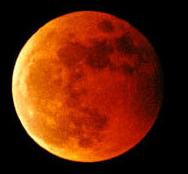Lunar Eclipses
-
The Moon can shadow the Sun's light as viewed from
the Earth, or the Moon can pass through the shadow cast by
the Earth. The former is called a solar eclipse and the
later is called a lunar eclipse.
The small tilt of the Moon's orbit with respect to the plane of the ecliptic (Sun-Earth plane) and the small eccentricity of the lunar orbit means an eclipse doesn't happen every month. However, partial or total eclipses are actually rather frequent.


Lunar Eclipses
The shadow cast by Earth has two parts: the total shadow
called the umbra and the partial shadow termed the penumbra.
If the moon becomes completely immersed into the umbra, a
total eclipse occurs. If only a portion of it falls into the
umbra, a partial eclipse occurs. Sometimes the moon only
enters the penumbra without touching the umbra. This is a
penumbral lunar eclipse.
Why does the Moon look red during total eclipse?
Some of the Sun's light
passes through Earth's atmosphere and is bent around and
behind the Earth. Much of this light is scattered as blue
light, and never reaches the lunar surface. Only the longer
wave-lengths of light (mostly red or orange) will reach the Moon,
tinting its surface in a coppery glow.
Upcoming Total Lunar Eclipses
You can be anywhere on these continents and view a Total Lunar Eclipse
(provided there are no clouds!). It is *not* dangerous for your eyes to
observe a Lunar Eclipse. NOTE: the date may be misleading if the eclipse
begins after midnight Greenwich Time. Pay attention to local news channels
to get the right night!
| Date | Where Totality is Visible |
|---|---|
| May 16, 2003 | North, South and Central America, Antarctica |
| November 9, 2003 | North, South, and Central America |
| May 4, 2004 | Africa, the Middle East, and India |
| October 28, 2004 | North, South, and Cent. America, West Africa, and Southern Europe |